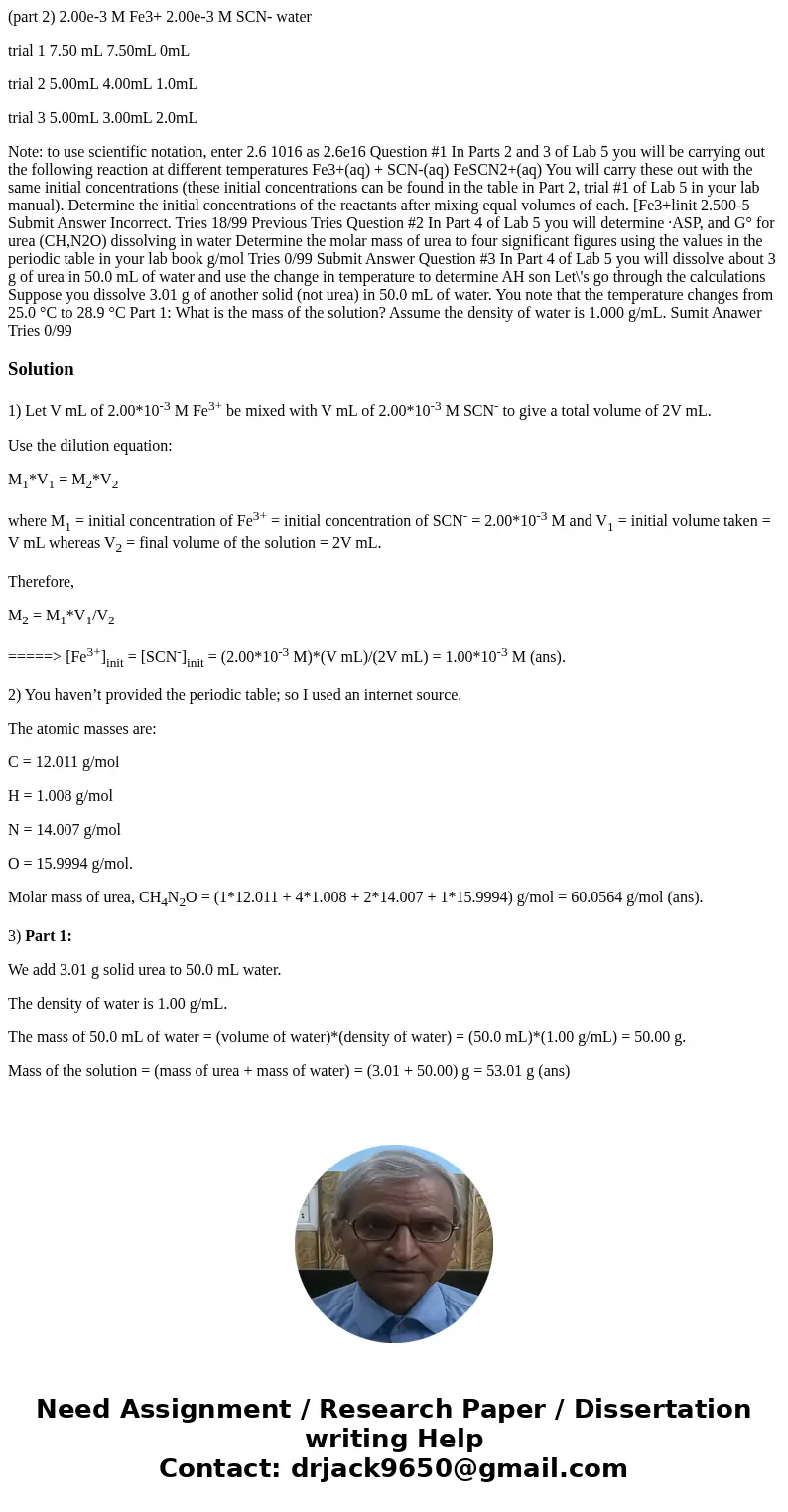part 2 200e3 M Fe3 200e3 M SCN water trial 1 750 mL 750mL 0m
(part 2) 2.00e-3 M Fe3+ 2.00e-3 M SCN- water
trial 1 7.50 mL 7.50mL 0mL
trial 2 5.00mL 4.00mL 1.0mL
trial 3 5.00mL 3.00mL 2.0mL
Note: to use scientific notation, enter 2.6 1016 as 2.6e16 Question #1 In Parts 2 and 3 of Lab 5 you will be carrying out the following reaction at different temperatures Fe3+(aq) + SCN-(aq) FeSCN2+(aq) You will carry these out with the same initial concentrations (these initial concentrations can be found in the table in Part 2, trial #1 of Lab 5 in your lab manual). Determine the initial concentrations of the reactants after mixing equal volumes of each. [Fe3+linit 2.500-5 Submit Answer Incorrect. Tries 18/99 Previous Tries Question #2 In Part 4 of Lab 5 you will determine ·ASP, and G° for urea (CH,N2O) dissolving in water Determine the molar mass of urea to four significant figures using the values in the periodic table in your lab book g/mol Tries 0/99 Submit Answer Question #3 In Part 4 of Lab 5 you will dissolve about 3 g of urea in 50.0 mL of water and use the change in temperature to determine AH son Let\'s go through the calculations Suppose you dissolve 3.01 g of another solid (not urea) in 50.0 mL of water. You note that the temperature changes from 25.0 °C to 28.9 °C Part 1: What is the mass of the solution? Assume the density of water is 1.000 g/mL. Sumit Anawer Tries 0/99Solution
1) Let V mL of 2.00*10-3 M Fe3+ be mixed with V mL of 2.00*10-3 M SCN- to give a total volume of 2V mL.
Use the dilution equation:
M1*V1 = M2*V2
where M1 = initial concentration of Fe3+ = initial concentration of SCN- = 2.00*10-3 M and V1 = initial volume taken = V mL whereas V2 = final volume of the solution = 2V mL.
Therefore,
M2 = M1*V1/V2
=====> [Fe3+]init = [SCN-]init = (2.00*10-3 M)*(V mL)/(2V mL) = 1.00*10-3 M (ans).
2) You haven’t provided the periodic table; so I used an internet source.
The atomic masses are:
C = 12.011 g/mol
H = 1.008 g/mol
N = 14.007 g/mol
O = 15.9994 g/mol.
Molar mass of urea, CH4N2O = (1*12.011 + 4*1.008 + 2*14.007 + 1*15.9994) g/mol = 60.0564 g/mol (ans).
3) Part 1:
We add 3.01 g solid urea to 50.0 mL water.
The density of water is 1.00 g/mL.
The mass of 50.0 mL of water = (volume of water)*(density of water) = (50.0 mL)*(1.00 g/mL) = 50.00 g.
Mass of the solution = (mass of urea + mass of water) = (3.01 + 50.00) g = 53.01 g (ans)

 Homework Sourse
Homework Sourse